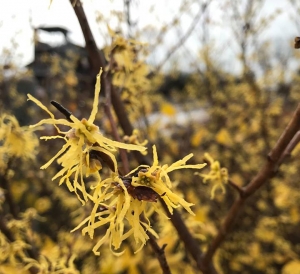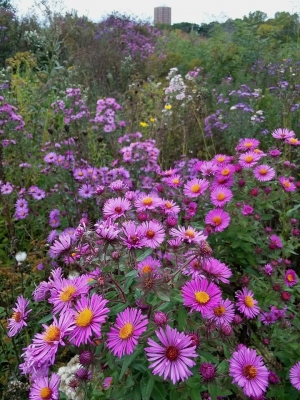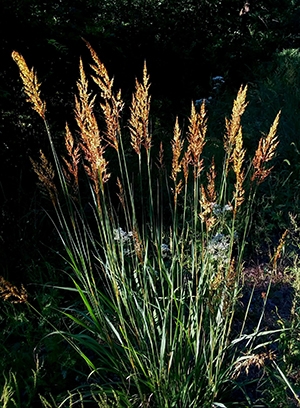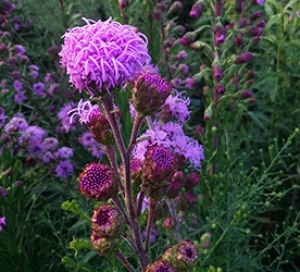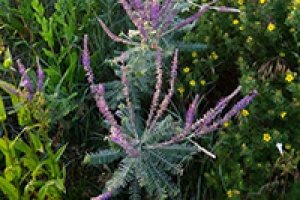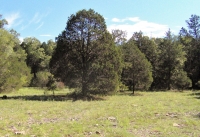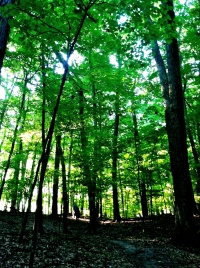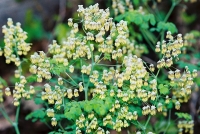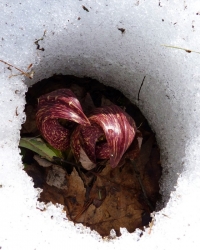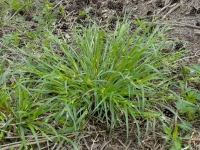

Joel Springsteen
Joel was born and raised in Papua New Guinea. While in middle school, a project to plant a backyard “rainforest" evolved into a full-blown obsession with habitat restoration. Soon after reaching a peak height of 6ft 2in, Joel moved to Milwaukee. He was amazed to discover that most native plants are conspicuously absent from the city and suburbs. He loves restoring native plant/animal communities because it combines history, ecology, and other disciplines. Joel has degrees in linguistics and biology with an emphasis in botany and conservation. He has been a land steward at the UEC since 2006.
Native Plants: Common witch hazel
Common witch hazel (CWH, Hamamelis virginiana) is hardly common in the wild and even less so in landscaping. In Milwaukee County CWH is only found in a handful of older growth forests. This unique large shrub or small multi-stemmed tree blooms October through November!
Native Plants: New England Aster & Downy Gentian
New England Aster (Symphyotrichum novae-anglea) is one of the most common native asters and when covered in one inch diameter flowers, it's also one of the showiest. This member of the daisy/sunflower family grows in a variety of soil types and moisture levels and is well adapted to disturbed areas like roadsides and young prairie plantings where it can be a dominant species.
Native Plants to Know: Indian grass
The Tallgrass Prairie ecosystem is both the most biodiverse in northern North America and one of the most endangered with 1% or less remaining. It is full of a wide variety of beautiful grass species and yet we industry continue to produce and market primarily nonnative grasses from Europe and Asia which do not contribute ecologically and have the potential to become invasive species. It is both patience trying and heartening to see more of our native grasses very slowly gaining traction in the landscaping industry including beautiful Indian grass (Sorghastrum nutans).
Native Plants to Know: Meadow Blazing Star
When it comes to attracting monarch butterflies for nectaring, meadow blazing star (Liatris ligulistylus) wins hands down! This patch had 15 monarchs on it before I got close to take a picture.
Meadow blazing star will grow in seasonally damp, medium, or slightly dry sites but it prefers loam to sandy loam soil with a good amount of organic material (not a fan of heavy clay). While it does best in full sun this is one of the better blazing stars for yards with partial shade.
Native Plants to Know: Leadplant
Those who prefer instantaneous beauty or plump plants may give up on leadplant (Amorpha canescens) well before it reaches "maturity" at 5+ years of age, but the patient gardener will be rewarded with decades of drought resistant silvery foliage and purple flowers.
Natural Community Spotlight: Cedar Glade
A cedar glade is a type of savanna found on sites that are naturally protected from fire and where the bedrock is exposed or comes very close to the soil surface. The cedar, after which this natural community is named, is eastern red cedar - also known as Virginia juniper (Juniperus virginiana). Red cedar is not a true cedar (genus Cedrus) although it is a member of the cedar family (Cupressaceae). The rocky, thin soiled environment of the cedar glade is too harsh for most trees to become established, but red cedar is able to grow in cracks in the bedrock or in random pockets of deeper soil. Consequently, trees in the glade grow widely spaced, in clumps, or in bands on the edges of the glade. This creates a mosaic of light and habitat structure for plants and animals with different preferences. Rare in Wisconsin, cedar glades are found in a few other Midwestern states and are most abundant, though still rare, in the central eastern United States where they are threatened by development.
Natural Communities: Southern Mesic Forest
This is the first in a series featuring the natural communities of Wisconsin. A natural community is a distinct and recurring group of interacting populations of microorganisms, fungi, plants, and animals and their physical environment. Because of our unique geographic location at the crossroads of several major ecosystems and the wide variation in soil type, temperature range, and moisture availability across the state, Wisconsin has a diverse mosaic of over seventy different natural communities. Southern Mesic Forest, the first natural community we will highlight, was once the most common natural community in Milwaukee County.
Native Plant: Early Meadow-Rue
The buttercup family (ranunculacea) has 1,700 species distributed around the world with about 70 occuring in Wisconsin. Some of the more familiar species include wild columbine (Aquilegia canadensis), virgin's bower (Clematis virginiana), marsh marigold (Caltha palustris), and American pasque flower (Anemone patens L. var. multifida). Early meadowrue (Thalictrum dioicum) is one member of the family blooming in the woods this time of year. With graceful grayish-green fern-like foliage, and dainty, tassel-like flowers, this one is worth finding on a spring walk.
Native Plant: Eastern Skunk Cabbage
What native Wisconsin plant is the first to bloom in the spring, generates its own heat capable of thawing frozen soil and melting snow, and produces flowers before leaves; flowers that emit a smell of rotting flesh?
Skunk cabbage!
Not a true cabbage, skunk cabbage is a member of a mostly tropical family of plants, the Arum family or Araceae. Other well known members of the Arum family include calla lilies, philodendrons, taros (elephant ears), as well as other native plants like Green Dragon and Jack-in-the-pulpit. Skunk cabbage gets its name from the pungent skunk-like odor released when any part of the plant is broken or damaged and from its large leaves which grow in a rosette somewhat like a cabbage.
Native Plant: Common Wood Sedge
Common Wood Sedge, Carex blanda, is one of the most ubiquitous native woodland plants. This lush yet tough plant is often seen growing next to paths indicating that it is well adapted to disturbed and compacted soils and that its seeds are spread via mud stuck to the bottom of shoes, paws, and hooves. The seeds may also be distributed by woodland ants. The leaves and seeds of native Carex are an important sources of food for wildlife.
Copyright © 2023 The Urban Ecology Center

